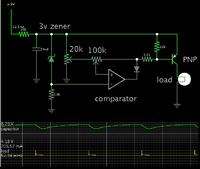navienavnav
Member level 1

- Joined
- Dec 12, 2011
- Messages
- 36
- Helped
- 1
- Reputation
- 2
- Reaction score
- 1
- Trophy points
- 1,288
- Location
- India.
- Activity points
- 1,627
I have a solar panel which is successfully able to run a small DC motor that I have as long as it is under direct sunlight. If not, it is unable to drive the motor (for example, in the presence of artificial light). What I am trying to do here is to charge a capacitor using the small current (slowly and over some time) which the solar panel produces under artificial or low light and when the capacitor is fully charged, AUTOMATICALLY make the motor run using the energy stored in the capacitor for a second or two and then again, AUTOMATICALLY, the capacitor should restart charging itself using the solar energy.
So the motor would run and then stop and then run and then stop over time as the capacitor charges and discharges.
Is it possible to do so using a capacitor without manually having to disconnect the solar cell when capacitor is charged and then connecting the capacitor with the motor? When I was a little I once had seen a small solar powered robot toy on Discovery Kids TV Channel which worked like that so I think it might be possible...
Can you help?
So the motor would run and then stop and then run and then stop over time as the capacitor charges and discharges.
Is it possible to do so using a capacitor without manually having to disconnect the solar cell when capacitor is charged and then connecting the capacitor with the motor? When I was a little I once had seen a small solar powered robot toy on Discovery Kids TV Channel which worked like that so I think it might be possible...
Can you help?
Last edited:



